Museums and Exhibitions in New York City and Vicinity
| Home | | Museum Guide | | International | | Architecture & Design | | Theater |
GLENN LONEY'S MUSEUM NOTES
CONTENTS, June 2005
Please click on "
* " to skip to each subject in this index:
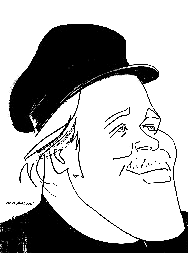
|
|
| Caricature of Glenn Loney by Sam Norkin. | |
FOREWARNED IS FOREARMED: *
At the Guggenheim: *
ART OF TOMORROW:Hilla Rebay & Solomon R. Guggenheim *
At the Nomadic Museum: *
ASHES AND SNOW:Gregory Colbert’s Mega-Photos *
At the American Museum of Natural History: *
DINOSAURS: Ancient Fossils, New Discoveries *
At the Dahesh Museum of Art: *
THE DAHESH COLLECTION:Celebrating a Decade of Discovery *
At the Metropolitan Museum of Art: *
ALL THE MIGHTY WORLD: *
The Photographs of Roger Fenton, 1852-1860 *
JOHN TOWNSEND: Newport Cabinetmaker *
ADORNING THE WORLD: *
Art of the Marquesas Islands *
Splotches, Whirls and Twirls *
In Madison Square Park: *
Sol LeWitt’s Concrete-Block Constructions *
At the Museum of Modern Art: *
FRIEDLANDER *
At the Whitney Museum: *
REMOTE VIEWING:(Invented Worlds in Recent Painting & Drawing) *
At the Frick Collection: *
From Callot to Greuze: French Drawings from Weimar *
At the Morgan Library: *
In Hardhats for a Construction-Progress Walk-Through *
At Knoedler & Company: *
MARK DI SUVERO: Indoors *
At the Queen Sofia Institute: *
Saluting The Hispanic Society of America: FROM GOYA TO SOROLLA *
At the Park Avenue Armory: *
The 45thAnnual New York ANTIQUARIAN BOOK FAIR *
High Up in the Reuters Building: *
These Streets Were Made for Walkin’ *
In Beacon/NY/at the DIA: *
DIA’S ANDY: Through the Lens of Patronage *
At the Getty Center on the Mountain: *
Looking Forward to the Wexner Center: *
On the eve of your reporter’s departure for various theatre & museum adventures in Colorado & Oregon, he suddenly lost all the commentaries he’d written—never to be retrieved from Microsoft Hell—after the report on John Townsend’s Furniture at the Met Museum. There is not time to reconstruct the commentaries, but the visuals from the shows are so compelling that they are provided with the briefest of comments on the contents of the various shows or their significance.
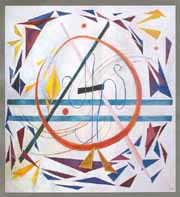 |
| Hilla Ribay. "Rhythmic Delight," 1950-56. Oil on canvas. Collecton of the Huber Family, courtesy Adler &Co. Gallery, San Francisco. |
ART OF TOMORROW:Hilla Rebay & Solomon R. Guggenheim
[Closing 10 August 2005]
Small wonder that Hilla Rebay persuaded Solomon R. Guggenheim to make the riotously colorful and fantastically inventive non-objective paintings of Vasily Kandinsky the core of his collection of Modern Art.Her own paintings and sketches—now on view at the Fifth Avenue branch of the worldwide Guggenheim Museums—are just as colorful, striking, and somewhat non-objectively similar in some cases to Kandinsky’s.
In fact, they are quite impressive and ingenious in their design-structures and color-choices. From the evidence of the works on view, Rebay was an important and innovative talent among the early 20th century Modernists, even if that seems forgotten today.
She was a capable figurative artist and portrait-painter as well. That is how she met and charmed Guggenheim, who commissioned her to paint his likeness. Rebay enjoyed exhibitions and acclaim on both sides of the Atlantic in a career that stretched from 1910 to 1960.
Hilla Rebay was also staunch friend and professional colleague of notable modernist painters such as Hans Richter and Jean Arp, as well as Kandinsky. His manifesto, On the Spiritual in Art, proved seminal for her and many others.
Heretofore, Rebay has been known—if at all—to Guggenheim visitors as the museum’s first curator and director. Some arts-experts, however, regarded her as Guggenheim’s Eminence grise—and not only in matters of arts-acquisitions.
Some others were annoyed at the pretension with which she was sometimes styled as the Baroness Hilla von Rebay. She was born in German Alsace—in Strasburg, in 1890: it was part of the Prussian Empire at that time—as Hilla Rebay von Ehrenwiesen. Her family was, in fact, among the minor aristocracy. As an artist, she came of age in Bavaria, where titles are still treasured.
In 1939, in Art of Tomorrow, Rebay and Guggenheim introduced outstanding examples from his collection in his Museum of Non-Objective Painting to New York art-lovers. More than 30 of these works are currently included in this important show.
Rebay’s appreciation of the talents of these artists has since been proved prescient. And she it was who believed Frank Lloyd Wright was the right spiritual force to design the new Guggenheim Museum.
Considering Hilla Rebay’s strong focus on the art of Vasily Kandinsky, it is entirely appropriate that this show will be mounted in September in Murnau and Munich. Kandinsky lived with painter Gabriele Münter in the "Rus-haus" in Murnau—and he even painted their wooden staircase in colorful designs.
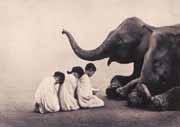 |
| "Ashes and Snow" ©Gregory Colbert |
ASHES AND SNOW:Gregory Colbert’s Mega-Photos
[Closed 6 June 2005]
In many of the world’s Port-Cities, there are stacks & stacks and hundreds & hundreds of unused steel Shipping-Containers, just waiting for some local merchandise to be crammed into them and shipped out to consumers elsewhere. In Hong Kong, there’s a whole valley filled with them.
If Gregory Colbert’s haunting photo-show, Ashes and Snow, is shipped to Hong Kong—as well it may be—there’s no shortage of containers to complete his dockside Nomadic Museum. Actually, its next port-of-call—after Pier 54 in Manhattan—is dockside Santa Monica, which also has a surplus of containers.
Indeed, as an astonishing example of Post-Post-Modern architecture, Shigeru Ban’s Paper & Container museum-shell-venue is almost as interesting as Colbert’s large free-hanging unframed sepia images. There’s even an overhead curtain of pressed dried Japanese teabags!
Inside, with its tall columns of tightly rolled paper, it suggests the extremely long ship-building hall in the Arsenal in Venice where Colbert’s photos had such a success in the 2002 Venice Biennale.
Ban already showed what he could do with paper and cardboard as basic construction-materials in the Japan Pavilion at Expo 2000 in Hannover. Everything is recyclable and reusable. Both of these achievements are amazing.
But the use of containers is especially ingenious, as there are so many of them lying around docks everywhere. The Nomadic Museum uses 148 containers in a checkerboard pattern, stretching out along Pier 54 at West 13th Street.
For the voyage to Santa Monica, the entire show will be packed into just 37 of these containers. The rest will be recruited from the large stocks on the docks wherever the show may go.
But aside from that, how did you like the show? Well, even before it opened, bus-stop panels were illuminated with arresting Colbert images, notably the one with an Arab standing among pillars as a hawk seems to hover overhead, wings wide outstretched. Or a tiny black child nestled in the curve of the trunk of a huge elephant.
Some disparaged these photo-images as too self-consciously constructed: too artfully, too purposefully designed.
But that’s what Colbert’s ardent art is all about: he is creating deliberately Iconic Images: visions of people interacting with Animals & Nature. That they are mostly Third World women and kids, and that the animals seem benevolent—although often violent in Nature—are important factors in the visual-equation.
In the paper & container venue, the large sheets of the individual photos are hung frameless from thin wires, spotlighted in amber light, to complement their sepia and umber tones. They are on handmade Japanese paper, in an encaustic process. No digital manipulation!
How fortunate for both the present & potential viewers and for Colbert that the President of ROLEX is a huge admirer & collector of his work: the touring Nomadic Museum is sponsored by that prestigious brand-name!
At the American Museum of Natural History:
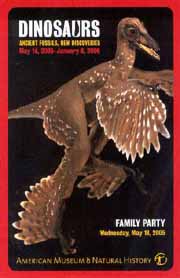 |
| "Sinornithosaurus millennii," Rod Mickens. © American Museum of Natural History. |
DINOSAURS: Ancient Fossils, New Discoveries
[Closing 8 January 2006]
This handsomely mounted new Dino Show at the American Museum of Natural History is designed not only to captivate the Public of All Ages, but to dispel some long-held but incorrect beliefs about Dinosaurs.
If you are a longtime fan of cartoonist Gary "Far Side Larson, you may think the reason the Dinos Died was that they were all standing around smoking cigarettes!
But if you are a really, truly Born-Again-Christian—who believes that every Word in the Bible is the Revealed Truth of God—you know that the World is only some 8,000 years old and that there were NO Dinosaurs, Wooly Mammoths, Mastodons, or Pterodactyls on Noah’s Ark!
We have the actual measurements for the Ark—set down in the Holy Bible—so where could Noah have put the Dinos anyway?
The explanation for the existence & discovery of Dinosaur Fossils is relatively a simple one for True Believers: The Lord God created these fossils to confound the impious, blasphemous, know-it-all, smarty-pants Secular Humanists!
The World and the Universe are not millions or billions of years old. And George W. Bush is a Faith-Based President! Even White Anglo-Saxon Protestants—or WASPs—are directly descended from Adam & Eve, who must have been Jewish! This may present a problem for those ardent Christians who are also anti-Semitic…
[I have this on Good Authority from a cousin who has long been Born-Again, so how could it be wrong?]
There is nothing about Bush or the Bible on view at the American Museum, but you can see a 700-square-foot walk-through diorama of animal and avian life 130 million years ago in Mesozoic Forest in China. The reconstructed environment and the animals are amazingly real, but nothing, of course, moves.
Fortunately, there are animated videos that can show you how some of these animals moved and lived.
You can also see the largest Mesozoic animal yet discovered—although a reconstruction from the fossil skeletal remains, it’s true. This is the Repenomamus giganticus.
Poster-Dino for this show is a strange kind of Feathered Dino: your reporter saw these first in China, where they were recently discovered. What Secular Humanists and Scientists now believe is that modern birds are related to the extinct dinosaurs! Do not let your parrot smoke!
The stated purpose of this special exhibition—which is not part of the impressive permanent Dino Halls—is to provide more accurate information about these ancient fossils and to introduce new discoveries. But it is also a very attractive and inter-active show as well. Who doesn’t love Dinos?
Jerry Falwell, Pat Robertson, Ralph Reed, Bill Frist, Tom DeLay, & James Dobson, perhaps? After all, nowhere in the Holy Bible is it written that God so loved the World that he created Dinosaurs! No Way!
You can buy stuffed Dinos and other Fossil-Stuff in the "Secular Humanist" show-shop.
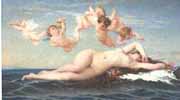 |
| Alexandre Cabanel. "The Birth of Venus," c.1865-1869. Oil on canvas. 33I/2x53I/2 inches. © Dahesh Museum of Art. |
THE DAHESH COLLECTION:Celebrating a Decade of Discovery
[Closing 22 September 2005]
For those New Yorkers who love Academic/Salon Art of the 19th century—British or Continental—the Dahesh Museum has been the center-point for the past ten years. Now, many of the Old Favorites of Dr. Dahesh’s permanent collection are now on view in celebration of the anniversary.
You can even see a quasi-reconstruction of a corner of Dr. Dahesh’s office in Beirut! Born Salim Moussa Achi, this leading Lebanese poet and intellectual assumed the Dahesh name at 21, when he began to write. It means "inspiring wonder" in Arabic, but today it would surely land him on President Bush’s NO-FLY List for persons with Arab or Muslim-sounding names!
Unlike the Blanket-Intolerance now a feature of our Leadership & Strategy, Dr. Dahesh’s own thinking and writing was dedicated to tolerance, human-rights, & justice, with no narrow sectarian limitations.
Although he was Lebanese, his greatest interest was in European Art & Sculpture. But his special focus was on paintings and sculpture dealing with Orientalisme and scenes & peoples of the Middle East. As a result, his collection became famous—and it included vintage photographs of such scenes and people.
In Dr. Dahesh’s time there were few—if any—Arab painters and sculptors at work in the Middle East. Actually, the Blessed Koran—as the Ten Commandments—forbids the creation of Graven Images or, indeed, any depictions of human-beings or animals. Only a forward-looking Christian Arab might feel free to take up a brush or a chisel…
While it is true that the Metropolitan Museum has some notable Academic Masterpieces, they are not spotlighted in the way that such art is at the Dahesh. Among the artists currently on view: Sir Lawrence Alma-Tadema, Rosa Bonheur, Gustave Doré, Alexandre Cabanel, Jean-Léon Gérôme, Vibert, Bouguereau, and Horace Vernet.
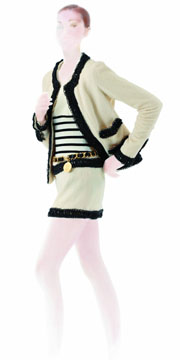 |
| Chanel by Karl Lagerfeld. Day Suit. Pret-a-porter, spring/summer 1994. Courtesy of CHANEL. Image by Karl Lagerfeld for the exhibition catalogue Chanel. |
At the Metropolitan Museum of Art:
CHANEL:
[Closing 7 August 2005]
Usually the annual Costume Gala Shmata-Show is confined below stairs in three rather cramped spaces at the foot of what once must have been a Grand Entrance Stairway—or an Unloading Dock. For Chanel, however, the show was given prime exhibition space, just off the Greek & Roman Sculpture Promenade.
In one sense, this recalled the great days of Diana Vreeland’s Costume Exhibitions in proper main-floor spaces. But in another, it failed. Vreeland understood very well how to show her frocks to Best Themed Advantage. There was always a real sense of overall show-design and showmanship.
Chanel, unfortunately, had her trademark confections confined to a series of banal white boxes, running in regimented rows in a very dimly lit low-ceilinged room. The entire room was gloom & doom, and even the light-levels in the individual semi-boxes was low. As though strong white light—instead of strikingly complementing a strong white Chanel suit with black piping—would actually cause the fabric to disintegrate.
Various styles and eras of the House Chanel/Lagerfeld were on display on uninterestingly posed dummy-women. This did not show these fabulous outfits to even Mediocre Advantage.
But then the Gala has always been much less about the museum-quality clothing on display and much more about the Museum-Quality Famous Ladies who plan the galas and who pose artfully for famous photographers in their own fabulous wardrobes. And, on the Night, most of the grand spaces of the Metropolitan are devoted not to the actual costume-show, but to the famous Celebrities who throng this Grand Met Money-Raiser.
The question is not: Did you see all those wonderful Chanel outfits on the mannequins?
But instead: Did your table have a clear view of Nicole Kidman?
 |
| All The Mighty World: The Photographs of Rodger Fenton, 1852-1860. Picture above, "Wollaton House." |
The Photographs of Roger Fenton, 1852-1860
[Closing 21 August 2005]
Considering the difficulty of making, exposing, and developing photographic-plates in the middle of the 19th century—when photography was in its infancy—it is a wonder that Briton Roger Fenton was able to capture so many memorable & archival images of The British Royal Family, Famous British Ruins, Nostalgic Landscapes, Kremlin Construction Projects, and the Fringes of the Crimean War.
Given the weight and awkward design of cumbersome cameras and tripods, it is remarkable that Fenton was able to manoeuver his equipment to take some of the more haunting of his historic photographs. He was not only a pioneer photographer but also one of the first real Photographer-Artists.
What is oddly interesting about him is that he gave up this Profession, Art, or Calling when cheaper cameras and the spread of popular photography made it impossible for him to earn a real living from his work. Fenton sold his cameras and equipment. He also resigned from the National Society of Photographers and returned to the practice of the Law!
Even though he had—among other achievements—set the standard of quality in photographing architecture, he put this all behind him. Not Epic Pique, but simple economics…
As I had myself photographed Rievaulx & Fountains Abbeys in the 1950s—as well as the DaVinci Code’s mysterious Roslin Chapel and the Cathedrals of Lincoln, York, & Salisbury—it was astonishing to discover from Fenton’s moody prints that they looked just as ancient and weathered in the mid-19th century as they did when I first saw them a hundred years later. That old stone weathers exceedingly slowly…
Like Fenton, I thought it important to preserve at least some images of these famous structures as they continued to age—and not always gracefully… The difference in our pictures is that mine are in color, whereas his are all in softly glowing sepia tones. Fenton likes to adorn ruins with occasional Victorians, leading against ancient walls and thriving ivy. I wait until the tourists are gone.
JOHN TOWNSEND: Newport Cabinetmaker
[Closing 25 September 2005]
It is certainly not true that when you have seen one lovely old chest you have seen them all. Nevertheless, when you have three or four of John Townsend’s chests, highboys, or desks set side-by-side the strong image of replication evokes an idea of Furniture as Rockettes: Precision & Synchronicity!
Although Boston, Philadelphia and Williamsburg are often cited as major centers of furniture-making in the Colonial Period and after, Newport was also a very important source of elegantly-designed and marvelously hand-crafted furniture.
Why a small city such as Newport should have such a thriving furniture-business was owing largely to the wealth acquired through its Port, a major harbor for various seafaring ventures. Wealthy sea-captains could adorn their mansions with the finest of everything: Import China & Domestic Desks! And a portrait of two dogs by Gilbert Stuart, perhaps…
The Goddard and the Townsend Families were the leaders in this Newport trade. Among them, John Townsend is today the recognized master. There are over 40 of his works in the current show in the Met’s American Wing. As well as other examples of Newport furniture crafts. There is even a modern wooden artwork that celebrates Townsend’s distinctive designs & ornaments.
Most notable was his use over almost three decades—1765-1792—of the strong Block-and-Shell design. On desks and chests, this had a central concave shell, flanked by convex shells, framed by the block from which they were carved.
But Townsend did not endlessly repeat himself. Chests and Secretaries gave way to card-tables. When Americans discovered Classic Greece and Rome, he introduced some elegant Neo-classic design elements.
Townsend was clearly proud of his work for he signed many pieces, unlike his fellow-craftsmen. To do this, he did not carve his name into the wood but pasted signed labels into drawers or on undersides of surfaces. Several examples are on display.
This extensive exhibition also provides some ancillary arts & crafts of the Pre- & Post-Revolutionary Period so it wouldn’t look entirely like a furniture showroom. Still, there are a lot of desks lined up with an intimidating precision.
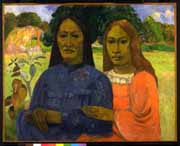 |
| Adorning th World: Art of the Marquesas Islands. Picture above, "Two Women." |
[Closing 15 January 2006]
Although this is a fairly small & compact exhibition, the ritual and cultural artifacts of the tribes of the Marquesas Islands are fascinating, especially the elegant Feather-headresses, the War Clubs, and the Ship Prow ornaments.
In modern times, these seven islands surfaced in the minds of arts-lovers as the source of Paul Gauguin’s inspirations for portraits of beautiful Polynesian women. He is buried in the Marquesas. Discovered in the 18th century by Captain Cook, the Marquesas achieved some note in the 19th as the site of Herman Melville’s Typee.
Marquesans are most famous for Totally Tattooed Bodies. No live or Tussaued examples are in this show, but there are vintage visuals. Great Stuff—but my report on this wonderful selection of native arts is now in Microsoft Hell, alas…
SOL LEWITT ON THE ROOF:
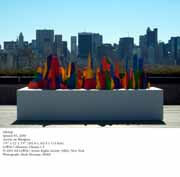 |
| "Sllong." Splotch #3, 2000. Acrylic on Fiberglass. 3'4" x 12' x 3'8". Le Witt Collection, Chester CT © 2005 Sol Witt/ Artisits Rights Society(ARS), New York. Photo by Mark Morosse, MMA. |
[Closing 30 October 2005]
The Splotches of Sol LeWitt actually look more like sleekly plastic Stalagmites, sitting primly on the floor of the Cantor Roof Garden at the Met. They are made of modeled foam, with fiberglass and epoxy-resin. The most impressive feature bright blue, yellow, green, and red colors on their shafts.
But, as LeWitt has often created entirely white ensembles of right-angled geometrics he calls "structures," there is one white Splotch, paired with a sleek black Splotch.
The colored Splotches look especially interesting against the Manhattan skyline on the Met roof.Whirls and Twirls is a wall-painting, designed by LeWiit, but executed by four artists over four weeks.
Great Stuff—but my full report on this colorful roof-display is now in Microsoft Hell, alas…
Sol LeWitt’s Concrete-Block Constructions
[Closing 31 December 2005]
Not only is the Art of Sol LeWitt on the roof of the Met Museum: it’s also on the ground at Madison Square Park! This part of the Madison Square Park Conservancy’s program of free outdoor art-exhibitions to enhance the historic park’s potential for the community and for tourists.
He has designed two structures of concrete-bricks. One is slightly serpentine—like Thomas Jefferson’s brick wall at the University of Virginia—but low, topped with concrete-brick columns. This LeWitt calls Curved Wall with Towers. His second artwork for the Park is Circle with Towers. Similarly, it is a low ring with the same concrete-brick columns.
On a recent sunny afternoon, mothers were sitting on the circle as kiddies frolicked around the columns.
Both Practical and Art-Architecture—but my full report on these structure/sculptures and the history of Madison Square Park & Garden is now in Microsoft Hell, alas…
 |
| Lee Friedlander. New York City, 1980. Gelatin silver print. 18 5/8 x 12 3/8" (47.3 x 31.5 cm) The Family of Man Fund. The Museum of Modern Art, New York.© 2005 Lee Friedlander. |
[Closing 29 August 2005]
Lee Friedlander has had a long and adventurous career, making powerful iconic images in stark black-and-white. Fortunately, he has been able to have his best photos preserved and presented in a series of handsome themed photo-books, so they are permanently on view anytime anyone opens a volume.
MoMA early bracketed him with Diane Arbus and Garry Winogrand, following with four solo-shows on varied themes. But this show is the most extensive retrospective, with over 500 images.
From the denseness and complexity of his Nature photos to his cluttered city street-scenes, it’s apparent that Friedlander loves the chaotic clutter of both Nature and Daily Life. His Nudes are something else: no clutter.
Great Shots—but my full report on this impressive exhibition of masterful photography is now in Microsoft Hell, alas…
REMOTE VIEWING:(Invented Worlds in Recent Painting & Drawing)
[Closing 9 October 2005]
There’s something here—both very colorful and complex—for both lovers of Non-Objective artworks and those who long for something more Figurative. Some of these visions are so densely rendered, with so much complicated detail, that one needs some time to study them closely and decipher, if possible, their secrets..
Others are so brash, bold, and colorful that their mysteries resound only afterward. Among the talents on view: Alexander Ross, Ati Maier, Franz Ackermann, Terry Winters, Julie Mehretu, Matthew Ritchie, Carroll Dunham, and Steve DiBenedetto.
Great Stuff—but my full report on this delightfully light exposition of imaginary worlds is now in Microsoft Hell, alas…
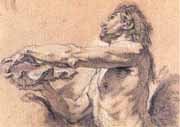 |
| Francois Boucher (1703-1770). "A Triton Holding a Stoup in His Hands (detail), 1752. Stumped black chalk, hightened with white chalk on cream paper, 328 x 297 mm. Schlossmuseum KK 9000. |
From Callot to Greuze: French Drawings from Weimar
[Closing 7 August 2005]
Because of the Cold War it was almost impossible to get a visa to the DDR to see the magnificent collections of the Grand Duke Carl August of Weimar. Your reporter from America was, however, able to visit the historic city of Goethe, Liszt, and Schiller, even in the 1950s.
But this is the first time that most Americans will be able to see the cream of the Ducal collection of 18th century French drawings. Some 70 sheets are now on view at the Frick. The poster-boy is François Boucher’s Triton Holding a Stoup in His Hands.
Also charming is Watteau’s elegant sketch of Two Dancers. Other Masters on view include Jacques Callot, Claude Lorrain, Simon Vouet, Jean-Baptiste Greuze, and Charles Lebrun.
Goethe, in addition to being director of the Grand Duke’s Hoftheater, was also Privy Counselor. An avid collector of French drawings himself, he counseled the duke to collect as well. Now the two collections have been merged, and the Frick is the temporary beneficiary of these loans of some of the best of the Weimar treasures.
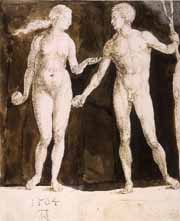 |
| Caption
to #13 picAlbrecht Dürer (1471-1528). Adam and Eve, 1504 Pen and brown ink, brown wash, corrections in white. 9 9/16 x 7 7/8 inches (243 x 200 mm). Purchased by Pierpont Morgan, 1910; I, 257d. © 2005 the Morgan Library. |
In Hardhats for a Construction-Progress Walk-Through[Opening Spring 2006]
The old/new and considerably expanded Morgan Library will open in Spring 2006. In the meantime, most of its invaluable collections have been in storage, awaiting completion of the new subterranean vaults, library-shelves, and reading-room.
Recently, the arts-press was invited to tour some of the raw spaces to get an idea of what would be where when it’s all finished. Renzo Piano’s innovative use of the limited formerly open-areas and the existing landmarked buildings is admirable.
The $102 million project will more than double space for exhibitions, research, preservation, storage, and public-programs. There will be a new and much larger auditorium below grade. Three glass & steel pavilions between the three major Morgan buildings are intended to create the effect of an Italian Piazza, facing out toward Madison Avenue, and 36th and 37th Streets. Light in the Piazza!
 |
| Mark di Suvero (b. 1933). "5," 2004. Stainless Stell, Steel, 18 3/4 x 29 x 16 1/4 inches. |
[Closing 12 August 2005]
Some summers ago, Mark di Suvero has a major outdoor exhibition of his large-scale works in brightly painted steel at Storm King Mountain Art Center. Four of these monumental sculptures remained in place and will be joined this summer by photographs of his works by Richard Bellamy.
As a kind of easier-to-reach pendant, Knoedler is currently showing ten of Mark di Suvero’s heavy metal confections. Some of these abstractions are very heavy. But all of them—ranging from 16 inches to 8 feet in height—are Kinetic. Instead of facing Don’t Touch signs, gallery-visitors are invited to gently rotate sculptural elements on their pristine pivots.
Saluting The Hispanic Society of America: FROM GOYA TO SOROLLA
[Closing 30 July 2005]
The Hispanic Society of American is 100 years old. It is located in a magnificent Beaux Arts complex on Audubon Terrace. Its collection of important Spanish paintings is the largest outside Spain itself.
But the Society’s free Museum & Library are sited way up Broadway, between 155th and 156th Streets. New Yorkers and tourists, passing by on buses up to The Cloisters, may have wondered at this remarkable architectural achievement, without stopping off to investigate.
So some of the most impressive—and representative—of the museum’s 19th and 20th century Spanish paintings have been temporarily hung on Park Avenue at the Queen Sofia Institute. Three large galleries are graced with visions of Spanish people in distinctive costumes and celebrations, as well as handsome landscapes and architectural images.
The poster-boy is not a Spaniard, but the American artist, Louis Comfort Tiffany, shown at his easel, palette and brushes in hand. He is backed and flanked by luxurious and colorful blooms, with his dog at his side. The lush impasto of color on the floral décor would upstage Tiffany, had not he worn a white suit for his sitting with the gifted Joaquín Sorolla. This was painted in 1911 for Tiffany’s villa, Laurelton Hall.
Also on view: Francisco Goya’s Portrait of Pedro Mocarte, Santiago Rusiñol’s Calvario at Sagunto, Joaquín Mir’s Tarragona Cathedral, and Sorolla’s glowing evocation of Youth & Beauty, After the Bath.
And after seeing these major and minor masterpieces, viewers will surely want to take the Muni bus up Broadway to Audubon Terrace!
The 45thAnnual New York ANTIQUARIAN BOOK FAIR
[April 2005]
Great Stuff—but my report on this wonderful exposition of rare and beautifully-designed books is now in Microsoft Hell, alas…
High Up in the Reuters Building:
These Streets Were Made for Walkin’
In early June, the Times Square Alliance made this presentation on the 30th floor of the gleaming new Reuters at the nexus of 7th Avenue & 42nd Street. The view is terrific. Uptown, you are looking right across at the globe/lantern atop the Paramount Building. Eastward lies the monster Lion King sign atop Condé Nast/4 Times Square.
The perceived problem is that the "Bowtie" formed by the midtown crossing of 7th Avenue and Broadway is already overrun with pedestrians, local and tourist. Pedlock, they call it.
London’s experiments in making the street between the National Gallery and Trafalgar Square into a traffic-free Pedestrian Mall were explored, followed by possible solutions for a Manhattan pedestrian problem that can only get much worse very soon.
But, if you ban buses, trucks, and cars in the bowtie, traffic-chaos will abound all around!
For more info, the Alliance is at 1560 Broadway, Suite 800, NY. NY 10036. Their brochure gives no phone, fax, or email, so look it up?
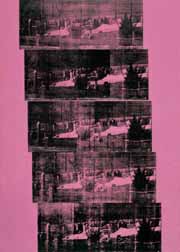 |
| Andy Warhol's "Gangster Funeral." |
DIA’S ANDY: Through the Lens of Patronage
[Closing 10 April 2006]
Where is Nabisco having its boxes made now? In Beacon, it has departed from two large box-factory-buildings, leaving the vast spaces for the DIA Art Foundation’s vast collection of often vast artworks. The focus-show for the recent art-press outing from Grand Central was an interesting exploration of various aspects of Andy Warhol’s popular & ubiquitous imagery. Colorful and impressive!
But Warhol is not alone in these great white halls: Dan Falvin’s fluorescent-tubes abound in a very long chamber. There is a huge pile of Joseph Beuys felts. One long room is crammed with large Richard Serra steel constructs.
Bernd & Hilla Becher’s black & white photos of German industrial details and water-towers are on view. Also Robert Ryman, Agnes Martin, Sol LeWitt, Bruce Nauman, Donald Judd…
Great Stuff—but my report on this expansive exposition of formerly Cutting-Edge Contemporary Art is now in Microsoft Hell, alas…
At the Getty Center on the Mountain:
The Memorial Day Weekend, leading American arts-critics met in Los Angeles for the first-ever National Conference of journalists and critics writing about Theatre, Music, Dance, Art, and even Jazz. What they learned is that newspapers are dying, editors discourage arts-coverage, readers aren’t interested in arts-reviews, and there are no jobs out there.
But they did get to spend an afternoon in a kind of Xanadu, J. Paul Getty’s immense mountain-top memorial, The Getty Center. This impressive multi-building Richard Meier-designed arts-complex is itself a complexity in the multitude of collections and the way they are linked.
Your reporter/photographer spent most of his time shooting details of Meier’s ingenious constructions.
Great Collections/Great Buildings—but my extended report is now in Microsoft Hell, alas…
In Downtown LA, on Grand, there are also some architectural wonders: Frank Ghery’s fantastic titanium exfoliation on the new Walt Disney Concert Hall and the remarkable new Cathedral of Our Lady of the Angels—which could also be called of the Our Lady of the ANGLES!
More on these after the next trip to "The Coast"…
Looking Forward to the Wexner Center:
 |
| Eva Hesse "Oomamaboomba," 1965 © The Estate of Eva Hesse. Hauser & Wirth Zürich London |
The Wexner Center at Ohio State University in Columbus was architect Peter Eisenman’s first public-building, in association with local architect Richard Trott in 1989. Originally idiosyncratic in the extreme, it has now undergone various restorations and changes to make it more welcoming to all the contemporary arts—including performance—which are celebrated on the campus.
After almost $16 million being expended, the Wexner Center will re-open this coming October. A press-preview in Manhattan made the Center and its planned programs look very interesting. Its generous arts patron Leslie Wexner is reputed wealthy from Lerner Shops, the Limited, the Avenue, Victoria’s Secret, and maybe the Body Shop. At least those were some income-sources mentioned unofficially.
All your reporter knows is that Mr. Wexner used to live next-door in the former Birch-Wathen School, remodeled at tremendous cost as a Private Palace.
Looking forward to a possible trip to Columbus and the Wexner Center in late October! [Loney]
Copyright © Glenn Loney 2005. No re-publication or broadcast use without proper credit of authorship. Suggested credit line: "Glenn Loney, Curator's Choice." Reproduction rights please contact: jslaff@nymuseums.com.